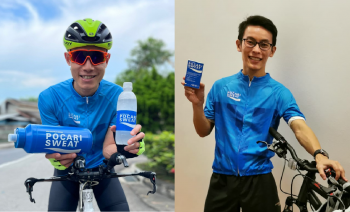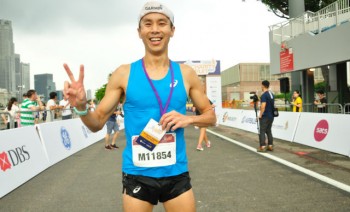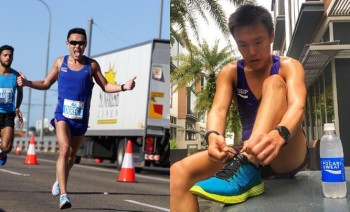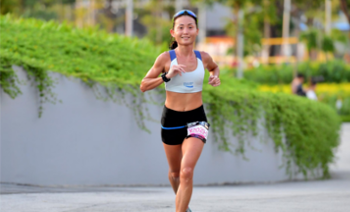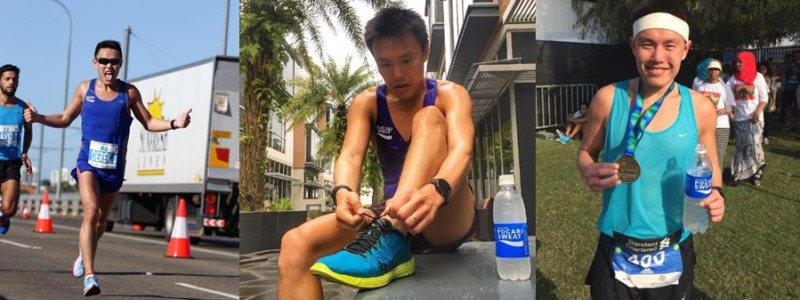
Choosing the Perfect Pair of Running Shoes with Dr. Derek Li
Updated: 09 Oct 2017 | Written By: Derek Li
Family physician by profession, running shoe addict by nature. Dr Derek Li loves to try out all sorts of running products and reviews them on his website http://runningcommentarysg.blogspot.sg/. He also runs very quickly in those shoes, having taken part in overseas marathons like the Boston and Berlin Marathons, run in 2h42min and 2h44min respectively.
What is your typical day like?
I usually start my day with a morning run at around 9am that lasts about 1hr. After that, I have an early brunch and head off to work at 12pm. My workday usually ends at 9:30pm, after which I will usually do a second run of 40-50mins when I get home. I am usually in bed later than most, and sleep at around 12:30am.
Share a personal story that inspired you to go the distance for your health?
I was not very fit for most of my teenage years. I had to enlist in National Service (NS) early because I could not hit the Silver award standard for NAPFA in school. Even during NS, I had to train very hard to finally get a Gold standard for IPPT in my final year of NS.
In 2002, I signed up for the (then) Nike REAL Run in Sentosa, because they were giving a very nice Nike t-shirt to the participants. I didn’t train at all for it, and only did the 5km as a fun run, but I saw all these other people who didn’t look athletic and they were all running faster and farther than me in the 10km race. That inspired me to come back and try the 10km race the following year.
So in 2003, I promptly signed up for the same race and this time I went for the 10km category. It also helped that the 2003 Nike Event t-shirt was a very nice baby blue colour and I still have it somewhere in my wardrobe. This time, I went for all the training runs organized by the race organizer SPANS. The training runs were held on Sundays from a carpark in Sentosa and there would be a Nike van there letting people try one of their new Nike Pegasus models, which was very cool.
Each week I would try to run with this Chinese uncle who I gathered was a member of the Police force, and each week he would crush me on the beach sections of the training runs, but I would hang on a little longer each time. I remember being amazed that this uncle with a crew cut of all white hair was running so easily while I was right on the limit. That really inspired me and made staying fit my lifelong journey.
By the time race day came, I managed to do the Nike REAL Run in 43mins, having just started doing my first ever 10km distance in training just 2 months prior. Ever since then, I got hooked on running and endurance sports, and the rest is history.
What are your top tips for people to improve their running / fitness?
Being consistent is the key. It is better and safer to do a little bit of exercise everyday than to do a lot only once in a while. Once your body gets used to doing a little exercise every day, the exercise becomes easier as you become fitter, and the exercise itself becomes more enjoyable too!
It also helps to work out with a group of like-minded friends, preferably of the similar fitness level so you can motivate one another.
What are the different types of running shoes available and do I need to own more than 1 pair?
By and large, modern running shoes are very versatile and would be able to handle recreational running easily. That said, there are some differences in the types of running shoes on the market, and this is mainly targeted at whether or not you need more or less stability or support in the shoe to help control your running gait. Broadly speaking, there are neutral shoes, stability shoes, and motion control shoes forming a spectrum of zero support for neutral shoes, to maximum support for motion control shoes. Then within each group, there will be subcategories into racing shoes, daily trainer or “premium” daily trainers which are more expensive and more cushioned than regular daily trainers in theory.
For newbies, it is best to get an idea of what kind of shoes you need first. The value of having an experienced salesperson assessing you to advise you on what type of shoe to try cannot be underestimated. The first tell-tale sign is to see whether the store has a treadmill on site for you to test out the shoe. Good choices are e.g. ASICS, New Balance or Nike concept stores. Some of the other more well-known concept stores are Running Lab or iRun, so these are good starting points.
I recommend starting with the daily trainer category as they are the most versatile “jack of all trades” type of shoes. Once you get more involved in running, then you can consider expanding your shoe collection to include shoes from other categories.
What are the most important features to look out for in a good running shoe?
The most important thing is comfort and fit, and this is very subjective. Some people prefer wider shoes and some prefer narrower shoes. Worse still, shoes are often not uniformly wide or narrow across the board; you can have a shoe with a narrow front, but a wide heel, so your heel slips out of the shoe easily when you run but the toes feel bunched up, for example. There is no easy way to discern what works for you, so it is best to try out a variety of brands and shoe styles to see what is most comfortable to run in. Never get fixated on any particular brand or even model of a particular brand, as the shoe designs change every year, and trends are always fluid so even within a brand, the same shoe model can evolve quite a lot of a few years.
Once you know what sort of fit you like, the next step is figuring out what sort of “feel” you like in a shoe. Again, this is highly individual and dependent on your running style, weight, and running pace. It takes a bit of trial and error to find out what type of feel you like in the heel and in the front of the shoe, but once you figure it out, it becomes quite easy just jogging on the treadmill to know whether you will like a shoe within 2-3 minutes of jogging.
The rest of the running shoe jargon is just window dressing and marketing speak.
How does the way I run affect the type of shoes I should choose?
The answer to this can probably take up a dissertation!
Simply put, if you tend to over-pronate and get ankle or foot pain from running in neutral shoes, then you may benefit from using stability or motion control shoes. If you tend to heel strike more, then you would usually run more comfortably in a shoe with a tradition heel-to-toe drop (i.e. a shoe with a higher heel and lower forefoot) in the 8-12mm drop range. If you tend to land more on the balls of your feet when you run, then you would probably be more comfortable running in a shoe with a lower heel-to-toe drop, ~0-4mm. There are certain brands, or shoe models that focus more on low drop shoe design, e.g. Altra, Hoka One One, Newton, Nike Free. Brands like Brooks or ASICS tend to focus more on the high heel-to-toe drop shoes.
What are some hydration tips you personally use when working out?
For easy runs, I make sure I drink lots of water before the runs and hydrate with POCARI SWEAT after.
For hard workouts and long weekend runs, I will drink POCARI SWEAT before the run, water during the runs (mainly because I usually refill from toilet sinks or watercoolers along the way), and POCARI SWEAT again after the run.
I don’t have a fixed volume I will drink, but I usually go through a 2L bottle of POCARI SWEAT for a long run, and a 900ml bottle for the hard workouts.
For the morning runs in particular, because our bodies tend to get dehydrated overnight, I will make sure I drink more before the run even if I am not particularly thirsty.
